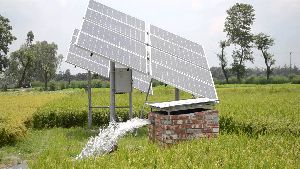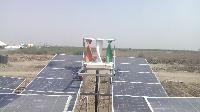
solar irrigation systems
Get Price Quote
Solar powered water pumps can deliver drinking water as well as water for livestock or irrigation purposes. Solar water pumps may be especially useful in small scale or community based irrigation, as large scale irrigation requires large volumes of water that in turn require a large solar PV array. As the water may only be required during some parts of the year, a large PV array would provide excess energy that is not necessarily required, thus making the system inefficient. Solar PV water pumping systems are used for irrigation and drinking water . The majority of the pumps are fitted with a 200 watt - 3,000 watt motor that receives energy from a 1,800 Wp PV array. The larger systems can deliver about 140,000 liters of water/day from a total head of 10 meters. By 30 September 2006, a total of 7,068 solar PV water pumping systems have been installed Solar water pumps are high efficiency pumps specifically designed to run from solar panels. Coupled with a suitable pumping maximiser or controller, they continue to pump in low light conditions such as cloud cover, early morning and late afternoons.

Solar Power Generation System
Get Price Quote
We design, build and support solar-wind hybrid power generation system from 1 kva to 1000 kva. It can be implemented at roof - top, open land, water body covering area and many other ways.
Best Deals from Solar Power Plants

Solar Home System
Get Price Quote
Solar Home System, Solar Panel, Solar System Kit

solar roof top
Get Price Quote
A solar PV power plant converts sunlight into electricity. It does so without any moving parts (unless it has a tracking system) and without generating either noise or pollution. A solar PV system can be installed at any un-shaded location such as on rooftops of buildings, car parking sheds, empty land, or even on top of canals and roads. Typical system sizes range from 240 watts to 100 MW. There is very little difference in the technical design between small kW-sized plants (typically de-centralized, off-grid) and large, MW-sized plants (typically centralized, grid-connected). Solar plants can easily be scaled using independent, modular components such as PV modules, inverters and batteries. The rooftops of buildings would be ideal for the installation of solar PV in City A typical rooftop solar PV system for a household is between 1-10kW. For larger buildings, such as offices or malls, it can reach 100 kW or more. Given Gujarat’s average irradiation of 5-5.5 kWh/m2/day, a kW of installed solar PV can generate 4-4.5 kWh of power during daylight hours, equivalent to the amount of power needed for a refrigerator to run for a day. A solar PV system consists of the following key components Solar PV array (group of modules) Solar inverter Battery Interconnecting devices (junction box, cables, distribution box) The PV array consists of solar modules interconnected with each other. The modules convert the energy from unlight, are held on structures made of galvanized iron, mild steel or aluminum and are inclined at a horizontal tilt, facing either south or east-west. Types of rooftop solar PV systems Rooftop solar PV systems are of 3 types: Grid-tied – These rooftop systems are primarily designed to supply the generated power to the grid and also power the load. These systems will NOT generate power during a power failure as the inverter shuts down the system to stop sending power into the grid and avoids the risk of electrocuting utility personnel who are working to repair the grid Grid-interactive – This system works in conjunction with either a battery backup or diesel generator to support the load even during a power failure. Off-grid – This system does not work with the grid and is designed to work only with a battery backup or diesel generator in off-grid applications The difference between the systems lies in the kind of inverter used, and the inclusion of batteries. As various vendors use different terminology for these systems we urge you to verify the functions of the offered system rather than going by the name alone Component cost of rooftop PV systems A rooftop solar PV system costs approximately Rs. 1,00,000 per kWp (kilowatt peak) including installation charges but without batteries and without considering incentives Rooftop and high efficiency solar modules High efficiency solar panels are coming in to their own at the moment. Many of the most efficient solar modules have a copper foundation, which makes them especially resistant to corrosion. Solar cell manufacturers are also swapping the weak connections in their cells with sturdier, thicker connectors. In the past, with these weak connections, if just one connection failed then that would mean that the whole cell was out of action. Present day solar cell connectors are much more resistant to failure, and also the loss of one connector does not have such a drastic effect on the rest of the cell. These new connectors are also designed to expand and contract in line with changes in temperature and sunlight levels throughout the day.

Solar Power System
Get Price Quote
Solar Power System, Ac Drive Panel, Electrical & Electronics Panels

Solar Power System
Get Price Quote
Solar Power System, Access Control System, Attendance System, Led Lights

Solar Rooftops
Get Price Quote

Solar Street Lighting System
Get Price Quote
Solar Street Lighting System, Solar Water Heater, Solar Pump

Solar Power Packs
Get Price Quote
Solar Power Packs, Air conditioner, Photocopy Machine, Flat Screen Monitor

Solar Rooftop System
Get Price Quote
Solar Rooftop System, Chemical Earthing System, Electrical Cables

Photovoltaic
Get Price Quote
Photovoltaic, Clarification / Sedimentation, Petrochemical